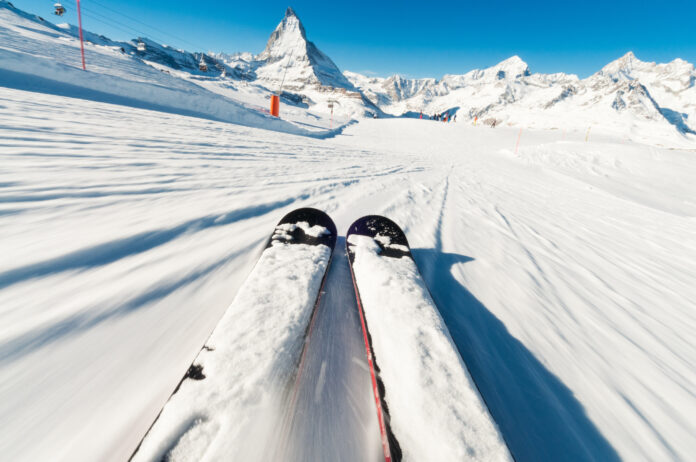Skiing is an awesome winter sport that has fascinated adventure-seekers and nature lovers for a long time. Whether you’re gliding down snowy slopes, tackling challenging terrains, or simply enjoying the stunning mountain views, skiing gives you a thrill like no other. Today we will discuss everything about skiing, including its history, different types of skiing, ski gear, techniques, and the best ski destinations around the world. So, get ready, put on your boots, grab your poles, and join us on an incredible journey through the snowy landscapes of this beloved winter activity.
The Origins and Evolution of Skiing
Skiing has been around for quite some time now. It actually started in snowy Scandinavia, where people used skis as a way to get around in the snow.
But over time, skiing became a fun recreational activity and even a competitive sport. In the 19th century, an important invention called bindings revolutionized skiing, allowing skiers to make precise turns and control their speed.
Skiing Disciplines
From Alpine to Nordic Skiing has different types, each with its own special characteristics and challenges. Alpine skiing is the most popular one and includes exciting events like downhill racing, slalom, giant slalom, super-G, and combined events.
If you’re into jumps and tricks, freestyle skiing is perfect for you, with its jumps, moguls, and aerial maneuvers. And then there’s Nordic skiing, which involves cross-country skiing and ski jumping, where endurance and precision are key.
Essential Equipment and Gear
To have an awesome skiing adventure, you need the right equipment. Let’s break it down and talk about the important stuff like skis, boots, bindings, poles, helmets, and clothing.
We are going to explain why these ski gears are special and how they have gotten better with technology & time. Also, we have covered some tips on picking the right gear according to your style of skiing and your skill level.
Skies
Skies are the main thing you need for skiing. They come in different types like all-mountain, freestyle, powder, and carving skis.
All-mountain skis are great for any kind of terrain, while freestyle skis are perfect for doing tricks and jumps.
Powder skis are wider and work awesome in deep snow, and carving skis are narrower for making quick turns on smooth slopes.
Boots

Ski boots are super important because they give you support and control and help transfer your power to the skis.
You want them to fit comfortably and snugly, with good support for your ankles and arches.
The cool thing is that advanced boots can be customized to make them even more comfy and perform better.
Bindings
Bindings are what connect your boots to the skis. They’re important because they release your boots during falls to keep you safe.
You’ll want to adjust them based on your weight, skill level, and boot size. Some bindings even have cool features like adjustable release settings and shock absorption.
Ski Poles
Ski poles help you with balance, rhythm, and pushing yourself along while skiing.
They should be light, durable, and the right length for your height. Adjustable poles are cool because you can change their length depending on the type of skiing you’re doing and your own style.
Ski Helmets
Helmets protect your head from injuries while you’re out there on the slopes.
Make sure to get a well-fitted helmet that doesn’t block your vision.
Some helmets even have ventilation systems and work with goggles and audio devices.

Ski Clothing
It’s essential to wear the right stuff to stay warm, dry, and comfy while skiing. Layering is key.
Start with a moisture-wicking base layer, then wear the insulating mid-layer, and then on the top, get waterproof and breathable clothing. Don’t forget gloves, goggles, and special ski socks too.
Skiing gear has gotten better over the years, thanks to technology. Skis now use lighter and stronger materials like carbon fiber, which makes them easier to handle and perform better.
Ski boots have become comfier with better insulation and liners that can be heated and shaped to fit your feet perfectly. Bindings have also improved to be safer and work with different types of boots.
When you’re choosing your gear, think about your style of skiing (whether you like groomed slopes, off-piste adventures, or doing tricks in the park), your skill level (beginner, intermediate, or advanced), and the type of slopes you’ll be skiing on (powder, smooth runs, or bumpy moguls).
It’s always a good idea to ask the experts at ski shops or experienced skiers for advice.
Remember, having the right gear that suits your needs will make your skiing experience even more awesome, keep you safe, and let you have a blast on the slopes.
Techniques and Skills
Mastering skiing techniques are super important if you want to become an awesome skier and stay safe on the slopes. These basic techniques and skills are beneficial for both beginner and expert skiers.
Snowplow Turn
This is a great technique for beginners. It’s like making a “pizza slice” shape with your skis.
By pointing the tips of your skis together and pushing out with your heels, you can slow down and make turns. This is a good technique to learn to control the speed and to stay in control.
Parallel Turn
Once you’ve got the hang of the snowplow turn, you can move on to parallel turns.
In parallel turns, both skis stay parallel to each other as you make your turns. It feels super smooth and helps you go faster while still having control.
Carving

Carving is a more advanced technique that looks really cool. It’s all about making really precise turns by digging the edges of your skis into the snow.
It feels like you’re drawing a line in the snow as you turn. Carving lets you go really fast and make turns with style.
Mogul Skiing
Have you ever seen those bumpy slopes with big bumps called moguls? Mogul skiing is all about going through those bumps like a pro.
You have to absorb the bumps with your legs and make quick turns to navigate through them. It takes a lot of agility and rhythm.
Off-Piste Skiing
This is when you venture off the regularly groomed slopes and go into more natural, ungroomed terrain like deep snow or powder.
Off-piste skiing is all about floating on top of the snow and making turns in different conditions. It’s important to learn about avalanche safety and ski with a buddy when you go off-piste.
Freestyle Skiing
If you’re into doing tricks and jumps, freestyle skiing is for you. It’s all about getting creative and doing cool tricks on jumps, rails, and natural features.
You can spin, flip, and grab your skis while catching some air. Freestyle skiing is all about having fun and showing off your style.
There are some important skills that will make you a better skier overall:
Posture and Balance
Keep your body in a good position and stay balanced while skiing. It helps you stay in control and have better balance on your skis.
Weight Distribution
Learn how to shift your weight between your skis to control your speed and turn shape. It’s like using your body to steer.
Body Movements
Bend your knees, use your arms for balance, and move your body in a fluid and controlled way. These movements will help you stay in control and make smoother turns.
Terrain Awareness
Pay attention to the slope, the conditions, and any obstacles around you. It helps you adapt your skiing techniques and stay safe on the mountain.
Remember, practice makes perfect. Take lessons from instructors who can help you improve your skills. Start on easier slopes and gradually challenge yourself on different terrains.
The World’s Top Ski Destinations

Get ready to discover some of the most incredible ski resorts around the world. We’ll take you on a virtual tour of famous ski destinations across different continents.
From the majestic slopes of the Swiss Alps to the legendary resorts of the Rocky Mountains in North America, and even the picturesque landscapes of Japan and emerging skiing hotspots in Eastern Europe, you’ll get a taste of the best ski spots on the planet.
Morzine is a popular skiing destination situated in the stunning French Alps. It offers a wide range of ski slopes suitable for all skill levels, making it an ideal place for beginners and experienced skiers.
The resort is known for its well-maintained runs, modern facilities, and friendly atmosphere. Whether you enjoy carving turns on groomed slopes or seeking more adventurous off-piste experiences, Morzine has something for everyone.
Additionally, the village has a vibrant après-ski scene, allowing you to relax and socialize after a day on the slopes.
With its excellent skiing opportunities and charming village ambience, Morzine is the perfect choice for a memorable ski vacation.
When you’re planning your ski trip from Geneva to Morzine, one of the most important aspects is finding a reliable and convenient transfer service.
You want your journey to be smooth and hassle-free, so you can focus on enjoying the excitement of the slopes.
With a trusted Geneva to Morzine transfer service, you can have peace of mind knowing that your transportation needs are taken care of.
They provide comfortable vehicles and experienced drivers who prioritize punctuality.
Whether you’re traveling with family or friends, this transfer service ensures a seamless transition from the airport to Morzine, allowing you to arrive safely and ready to make the most of your skiing adventure.
Safety Tips and Environmental Considerations
Safety must be your priority when skiing to get the most out of this amazing sport. Here’s a detailed guide to help you stay safe while enjoying your skiing adventure.
Warm-up Exercises
Before you start skiing, it’s essential to warm up your muscles. Do some simple stretches and exercises to get your body ready. It’ll help prevent injuries and make your skiing experience even better.
Mountain Conditions
Always stay informed about mountain conditions. Check the weather forecast, look out for avalanche risks, and know which trails are open. Pay attention to any warnings or closures given by the ski patrol or mountain staff.
Ski Etiquette
Following some basic rules while skiing will make the slopes safer and more fun for everyone. Here are a few important ones:
Yielding: Give way to skiers below you or ahead of you when you’re merging onto a trail or passing them.
Control: Ski in control at all times. Try not to be too quick or ski recklessly because it can be dangerous for you and other fellow skiers. Try to be in control and enjoy skiing.
Stopping: Choose a safe spot to stop if you need to take a break. Try to move to the side of the trail where you won’t block others. When you’re ready to start skiing again, make sure to look uphill to make sure it’s clear.
Safety Gear
Wearing the right gear is essential to protect yourself while skiing. Here are some key items:
Helmet: Always wear a helmet designed for skiing. It protects your head in case of falls or collisions.
Goggles: Goggles are important to protect your eyes from the wind, snow, and sun. Choose goggles that fit well and have good visibility.
Clothing: Dress in layers to keep warm and dry. Wear waterproof and insulated jackets and pants. Don’t forget to wear gloves or mittens to keep your hands cozy.
Sunscreen: Apply sunscreen with a high SPF 30+ to protect the skin from the harmful sun’s rays, even on cloudy days. Sunburn can still happen when you’re out in the snow.
Environmental Responsibility
We all need to take care of the environment while enjoying our skiing adventures. Here’s how you can contribute:
Stick to Marked Trails: Ski within the designated areas and avoid going into restricted or environmentally sensitive zones. This helps protect the natural surroundings.
Keep it Clean: Dispose of the trash properly, and if you see any garbage, pick it up and put it in a garbage bin. Let’s keep our slopes clean and beautiful.
Respect Wildlife: Enjoy watching wildlife from a distance and avoid disturbing their natural habitats. Don’t feed or approach animals you encounter while skiing.
Conserve Resources: Be mindful of water and energy usage at mountain facilities. Reduce waste and recycle whenever possible. Every little action counts.
By following these tips, you can have an amazing skiing experience while staying safe and respecting the environment. Remember, safety comes first, so be aware of your surroundings and have a blast on the slopes.
Conclusion
Skiing is not just a sport; it’s a fun activity that millions of people enjoy worldwide. Whether you’re seeking an adrenaline rush, a peaceful mountain getaway, or a chance to push your limits, skiing has something for everyone. From its humble beginnings to the thriving industry it is today, skiing has captured the hearts of people from all walks of life. So, if you’re looking for an exciting winter adventure, grab your skis, feel the wind on your face, and conquer the sloppy, snowy mountains. The slopes are calling, and the world of skiing is waiting for you to explore.
Recommendation
Best Travel Backpack For Women
The World’s Best Black Sand Beaches
How to Explore Pangong Lake in Ladakh: The Complete Guide
Mysterious Haunted Places in California
Frequently Asked Questions:
How long has skiing been around?
Skiing has been around for thousands of years, originating in snowy Scandinavia as a means of transportation.
What are the different disciplines of skiing?
Skiing encompasses various disciplines such as alpine skiing (downhill, slalom, giant slalom, super-G, and combined events), freestyle skiing (jumps, moguls, and aerial maneuvers), and Nordic skiing (cross-country skiing and ski jumping).
What equipment do I need for skiing?
Essential equipment includes skis, boots, bindings, poles, helmets, and appropriate clothing. You need to select the gear depending on your skiing style, skill level, and the type of mountain you’re going to be skiing on.
What techniques should I learn for skiing?
Skiing techniques range from basic turns as the snowplow turns to advanced moves like carving and freestyle tricks. It’s important to focus on posture, balance, weight distribution, and body movements.
What are the best ski destinations in the world?
Some popular ski destinations include the Swiss Alps, the Rocky Mountains in North America, ski resorts in Japan, and emerging skiing hubs in Eastern Europe.
How can I ensure safety while skiing?
Safety is crucial in skiing. Warm-up exercises, awareness of mountain conditions, following ski etiquette, and using appropriate safety gear are all important factors to consider.
Is skiing suitable for all skill levels?
Yes, skiing caters to all skill levels. Skiing can be challenging for beginners and even for expert skiers in some situations.
What makes skiing more than just a sport?
Skiing is not just a sport but a way of life embraced by millions worldwide. It offers a unique blend of adventure, relaxation, and personal growth.
How can I get started with skiing?
To get started, you can find a ski resort or training center near you that offers lessons for beginners. Learning from experienced instructors is a great way to start your skiing journey.




